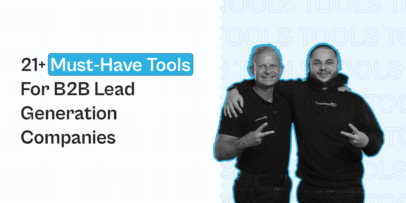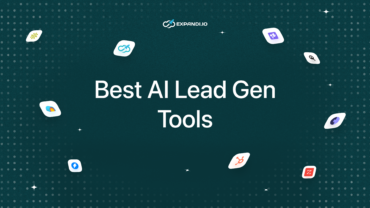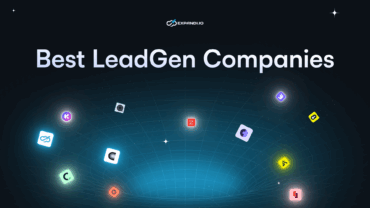6 Essential Sales Forecasting Tools for Success To Stay Ahead of the Game
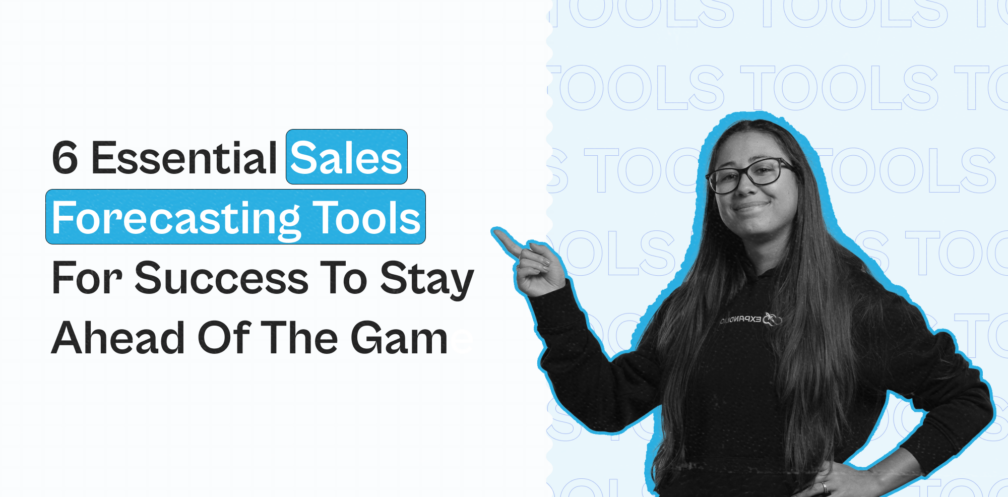
The right sales forecasting tools can help you predict future sales, empower data-driven decisions, and help fill up your sales pipeline.
Before you start deciding on the right forecasting tool though, you need to make sure that all the revenue-generating departments within your company speak the same language.
So, instead of simply listing the top 6 tales for sales success and running away, here’s what you’ll learn:
- What is sales forecasting software and how does it work?
- 5 Main features to look for in sales forecasting tools before deciding.
- Top 6 sales forecasting tools for 2024.
What Is Sales Forecasting Software And How Does It Work?
First things first, how do sales forecasting tools work, exactly?
Essentially, they can help you predict future revenue by processing your previous and current sales data. This includes data like:
- Lead volume.
- Pipeline volume and value.
- Average sales cycle length.
- Closing probability (though, this also depends on your sales closing techniques).
- And other sales forecast methods.
Done right, sales forecasts can also affect the decisions of potential investors, depending on your business model.
The accuracy of this, however, also depends on the quality and comprehensiveness of your sales data.
So, it’s not like you can just choose the “right” sales forecasting tool and expect success.
Another important tool in achieving sales success is your customer relationship management (CRM) software. Together with sales forecasting tools, you gain insights and data needed to make well-informed decisions, identify opportunities, and predict revenue growth.
CRM works by centralizing all of your customer interactions and data in one place, enabling you to manage and analyze customer relationships more effectively.
And sales forecasting tools work by analyzing your historical sales data and current sales pipeline to predict future sales performance.
By integrating sales forecasting into your CRM, you start to gain a holistic understanding of your customer base. This, in turn, helps you predict revenue growth with greater accuracy.
That said, depending on the software, there are 3 different kinds of forecasting:
- Sales forecasting – Using past sales data to predict future sales. This way, you can set targets, KPIs, tweak production, and track long-term sales performance.
- Demand forecasting – Estimating future demand for your solution. This involves predicting the quantity of goods or services your consumers purchase within a specific period, given your sales data.
- Financial forecasting – Finally, financial forecasting predicts how your company will perform financially. This looks at your past finances, marketing trends, and economic factors to estimate future revenue, cash flow, expenses, and more.
Now that you have an idea of how sales forecasting works, let’s take a look at how to approach choosing the right tools for sales success.
What Should You Look For In Sales Forecasting Tools? 5 Features To Consider
Wondering how to choose the right sales forecasting tool?
Here are 5 features to keep in mind when picking the right software for your B2B sales pipeline.
- Compatibility and integration: Regardless of the sales forecasting tool you go with (full list below), it should seamlessly integrate with your current tech stack. For example, if you use Salesforce as your CRM, your sales forecasting tool should be able to easily pull data from it without manual entry.
- Ease of use: A friendly user interface is essential for efficient use both by sales reps and leaders. Look out for tools with intuitive designs and clear navigation, so that you don’t have to create internal guides and content for your sales team on how to use the tools.
- Reporting and visualizations: Can your sales forecasting tool create hypothetical scenarios? You’ll need clear reports and dashboards with charts, graphs, tables, and other elements to help understand data and communicate it to business stakeholders.
- Types of sales forecasting: The tool should offer different types of forecasting methods, such as regression, moving averages, and different sales scenarios (what-if, best-case, worst-case).
- Team collaboration: The tool should support feedback by allowing you to share your findings with your sales team, executives, or managers as needed to gain their input.
Another thing to consider is if the sales forecasting software makes sense for you specifically.
As you’re about to see below, we’ll cover tools for different industries with different budgets and key features.
Let’s take a look.
Top 6 Sales Forecasting Software For 2024
1. Salesforce
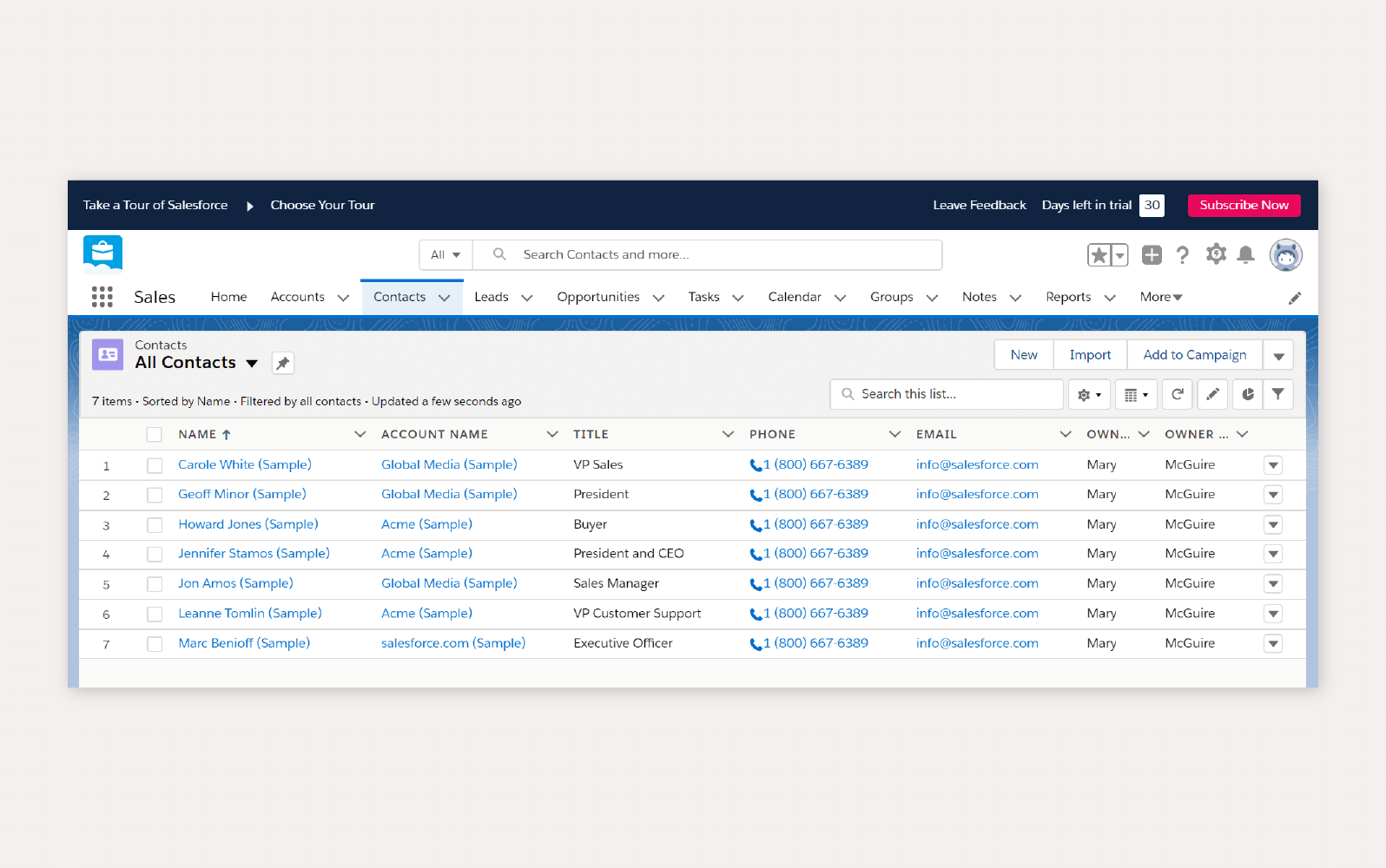
Salesforce is a cloud-based sales automation and CRM platform that offers a ton of powerful sales forecasting features.
Mainly, it uses historical data and AI to make predictions about your future sales revenue.
Because of its versatility, Salesforce can be an ideal solution for businesses ranging from SMBs to large enterprises.
In Salesforce, you can set custom forecast reports and dashboard views. You can also track complex sales processes, sales overlays, by revenue, contract value, and more.
Salesforce key features:
- AI-driven predictive analytics for accurate sales forecasts.
- Seamless integration with other Salesforce products and third-party applications.
- Customizable dashboards and reports for real-time insights.
- Advanced pipeline management to track sales progress and performance.
Salesforce comes with a ton of support software for your tech stack, depending on your requirements. But if you’re looking for sales forecasting, that feature only comes with their Enterprise solution and upper tiers.
Salesforce pricing:
- Starter suite: $25/user/mo.
- Professional: $80/user/mo.
- Enterprise: $165/user/mo.
- Unlimited: $300/user/mo.
- Einstein 1 Sales: $500/user/mo.
2. HubSpot sales forecasting tool
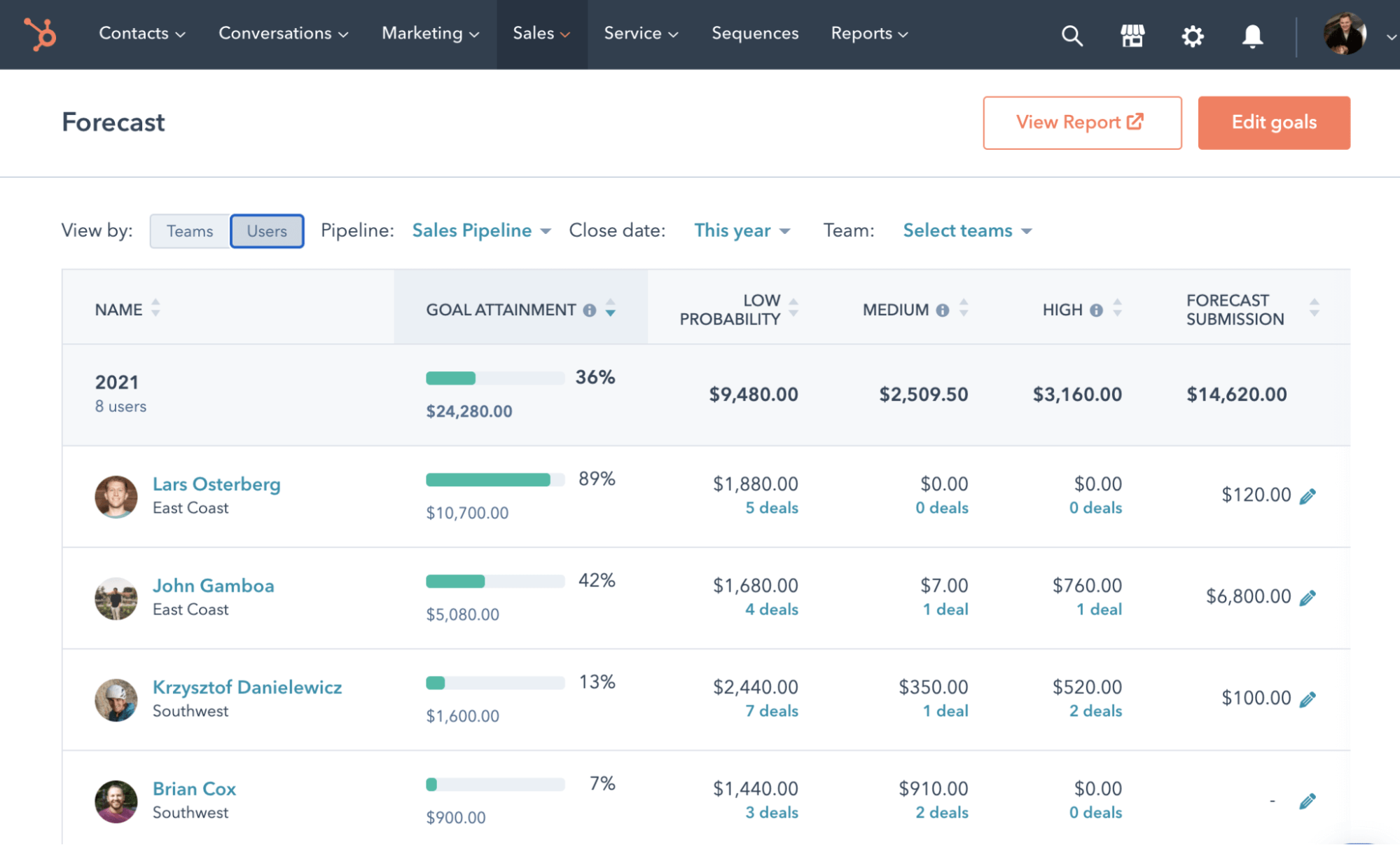
HubSpot is a leading company in cloud-based marketing, sales, and customer service tools.
On top of that, they also offer a forecasting tool to help you project future revenue and monitor pipeline leads.
If you’re already using HubSpot CRM (which is free), here’s what their sales forecasting product can offer:
- Comprehensive forecasts which help sales and service managers quickly see a high-level forecast breakdown by the team.
- Forecast across multiple pipelines to avoid the hassle of exporting deal data into spreadsheets for multiple pipelines. HubSpot’s forecasting tool provides a seamless, integrated view directly from your CRM. Then, sales teams can instantly access monthly or quarterly revenue projections, while service teams can create their own pipelines to monitor renewals and upgrade deals efficiently.
- Leveraging forecast reporting and analytics to gain at-a-glance performance metrics. With the tool’s different forecast categories, weighted sales pipelines, historical snapshots, and tons of other filters, you can instantly gain access to the information you need and share or manage accordingly.
HubSpot’s sales forecasting feature is only available to premium users of Sales Hub and Service Hub software, which costs as follows:
- HubSpot Sales Hub: $90/user/mo or $150/user/mo.
- HubSpot Service Hub: $90/user/mo or $130/mo/user.
This feature is only available in premium editions of Sales Hub and Service Hub. See the pricing page for more information.
3. Gong.io
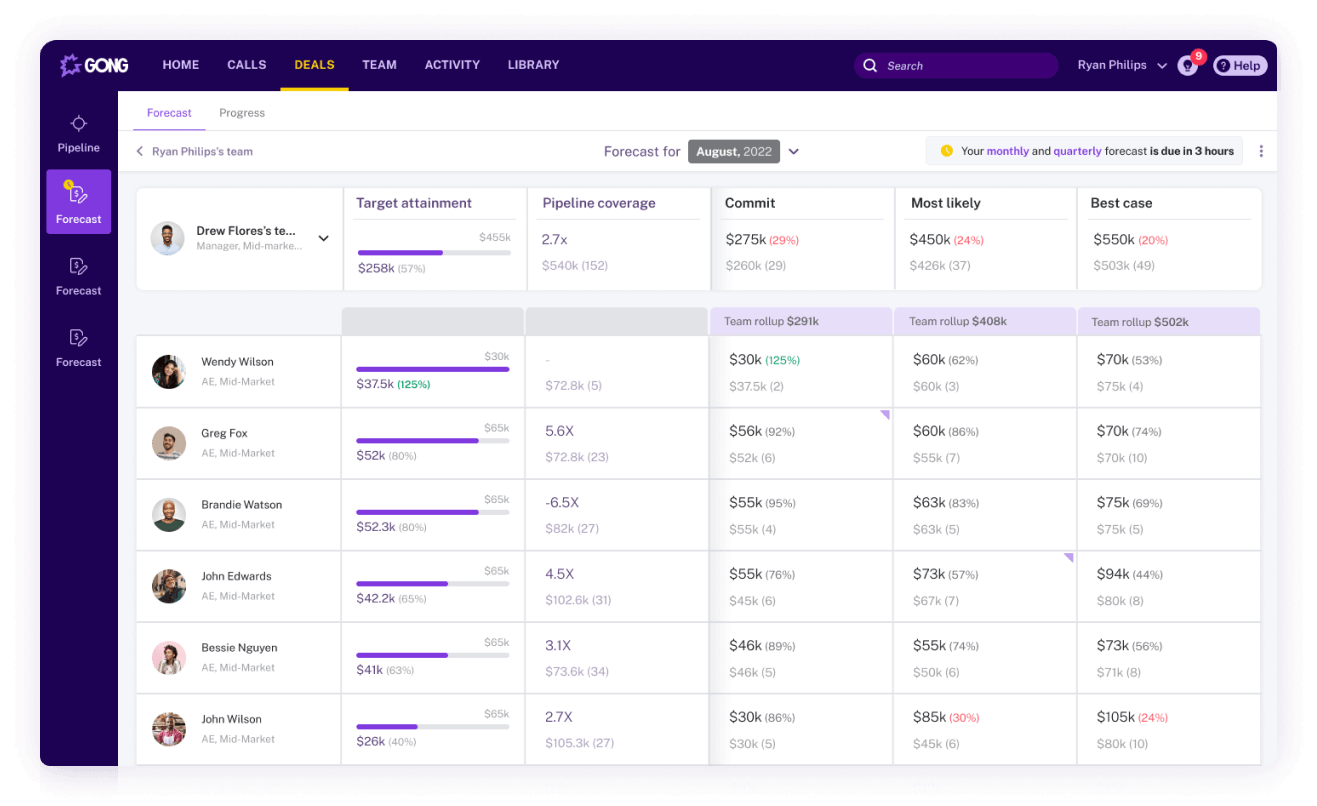
Gong.io is an all-in-one revenue intelligence platform that engages your customers, forecasts sales accurately, and improves team productivity.
In terms of features, the platform offers forecasting, engaging, data insights, AI, and more, mainly empowering enterprise companies.
Here are some of their key features for sales forecasting:
- AI forecast projections: Gong leverages 300+ unique signals to predict deal outcomes with 20% more precision than algorithms based solely on CRM data.
- Deal likelihood scores: The platform can boost manager capacity and raise sales rep performance with AI that helps teams prioritize and win deals that matter the most.
- Analytics and reporting: With Gong, you can stay ahead of pipeline risks and optimize revenue performance. The tool offers out-of-the-box sales analytics that brings deal, pipeline, and team insights into a single view.
- And more: Conversation intelligence, pipeline inspection, executive dashboards, CRM sync & enrichment, and more.
Gong pricing depends on your license type, team size, and more.
So, you’ll need to fill in their form here to receive a customized proposal with the pricing.
4. Forecastio
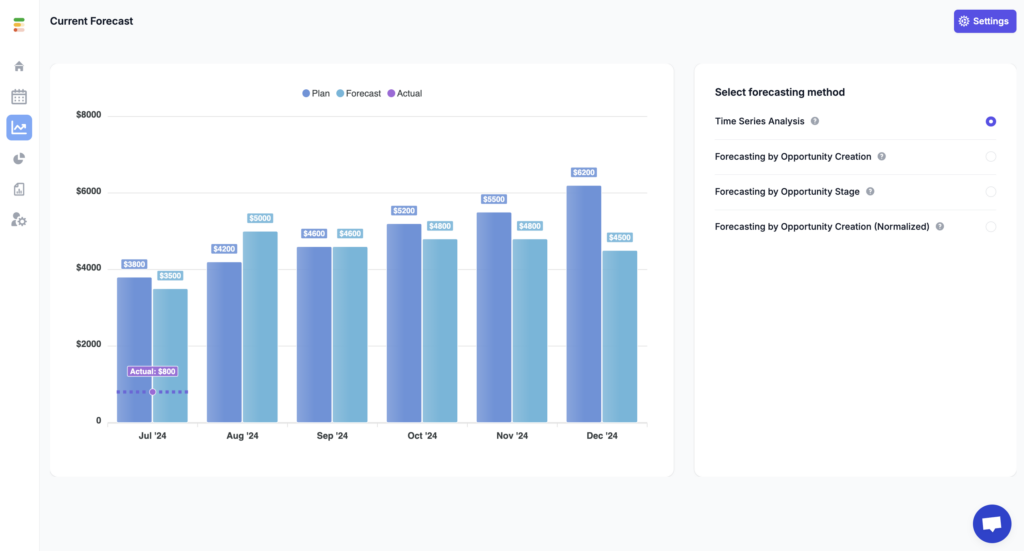
Forecastio is an AI-powered sales performance management platform for HubSpot users. It helps sales teams optimize forecasting activities using advanced AI and machine learning algorithms.
Forecastio key features:
- Multi-method forecasting – Forecastio supports various forecasting methods, including time-series analysis, pipeline creation forecasting, and pipeline stage forecasting. This flexibility allows businesses to choose the most suitable approach based on their data availability and sales processes.
- AI-powered insights – The platform’s advanced AI capabilities analyze historical data to identify patterns and trends, enhancing forecast accuracy and providing valuable insights for decision-making.
- Real-time analytics – With up-to-date insights and dynamic reporting, Forecastio enables sales teams to make timely, data-driven decisions.
- In-depth pipeline analysis – Users can conduct thorough pipeline analyses to identify areas for optimization and improvement.
Benefits:
- Improved forecast accuracy through multiple forecasting methods and AI-driven insights
- Increased efficiency by automating the forecasting process
- Actionable insights for optimizing sales strategies and performance
Pricing:
Forecastio offers a straightforward pricing model with plans starting at $149 per month, making it an accessible option for businesses of various sizes.
5. Clari
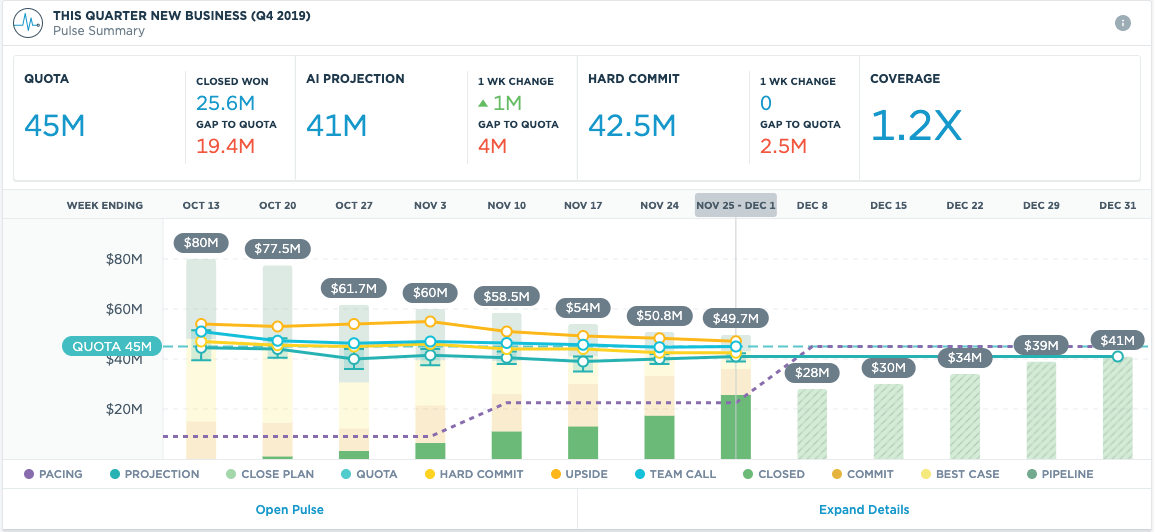
Clari is a revenue platform for enterprise companies looking to create, convert, and close leads – all in one place. They handle all things data automation, team performance, sales forecasting, retention and expansion, strategy management, and more.
This sales forecasting tool is mainly for RevOps, sales, marketing, post-sales, finance, sales engineering, and executive teams. Across different industries such as tech, healthcare, business services, finances, manufacturing, and more.
Here are some of the key features that make Clari stand out:
- Sales forecasting – Clari’s powerful forecasting solution adapts to any revenue model, including subscription and consumption-based, and offers many different self-service customization of tabs, fields, and formulas.
- Unmatched forecast accuracy – Clari claims to achieve 98% forecast accuracy by week two of the quarter. This then helps you hit sales numbers with powerful inspection tools, accurate rollups, and intuitive rep experiences that streamline the forecasting process.
- Clari capture – Clari automatically captures every email, contact, meeting, and download in one place. Then, it cleans and enriches that data with the right contacts and opportunities.
To see Clari pricing, you’d need to request a demo and get a quote that way.
6. ClickUp
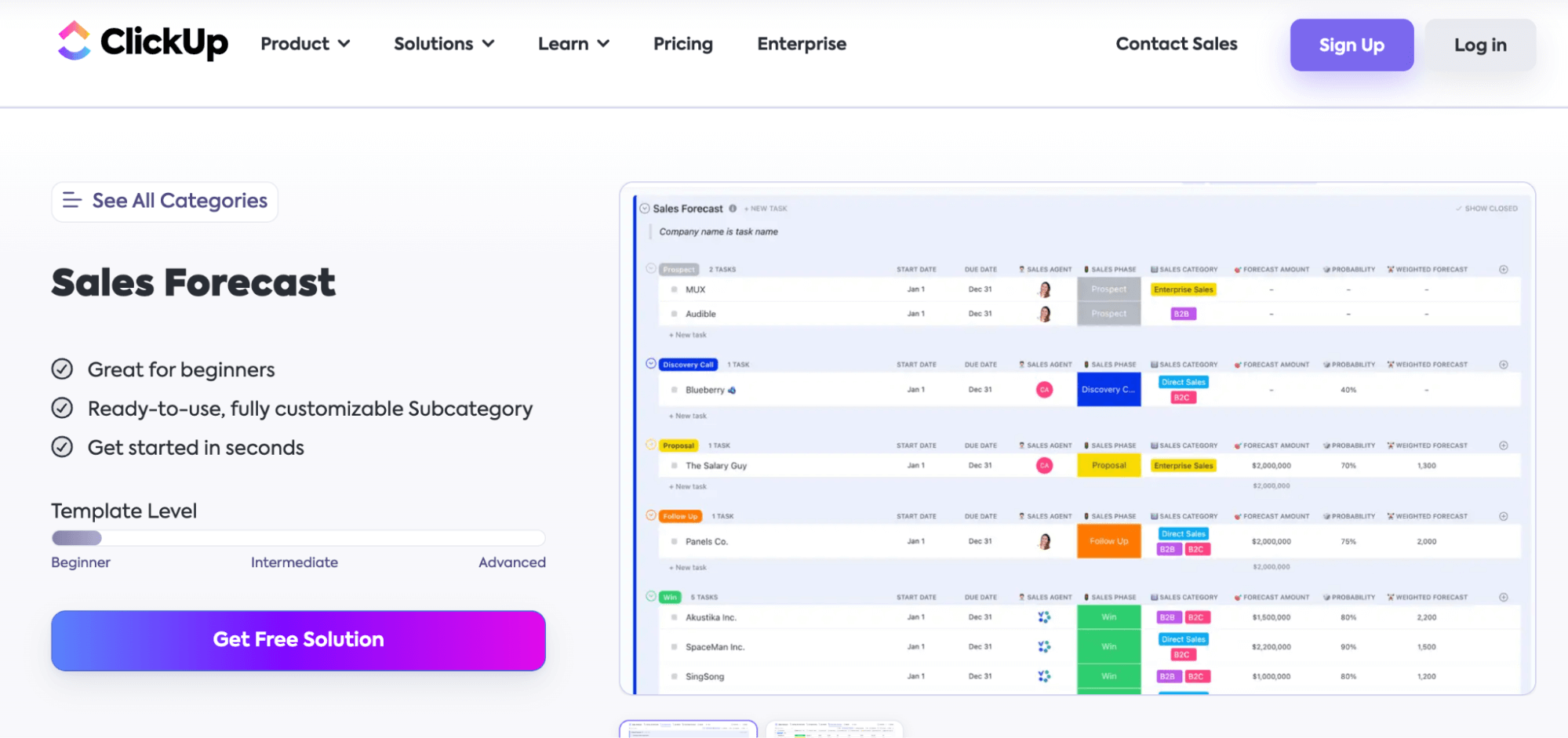
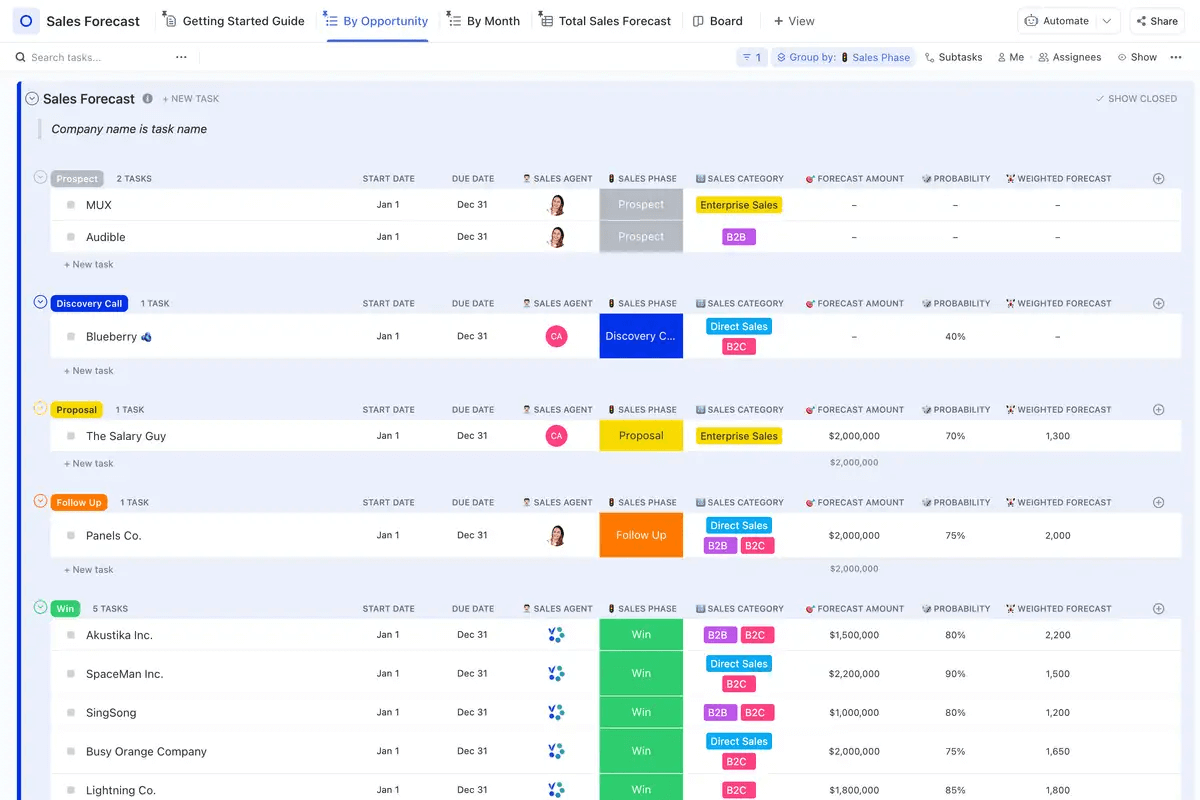
Last but not least, ClickUp is an all-in-one tool for marketers, sales teams, project management, automations, and much more.
If you’re looking for one tool to handle just about everything you’d need in marketing, sales, task and project management, and more, without breaking your budget – ClickUp is for you.
In terms of sales forecasting, here’s what they offer.
- Everything in one place – ClickUp provides solutions for your every need. Including project management, sales enablement, project dashboards, to-dos, and so much more.
- Simplified sales forecast templates – Predict short-term and long-term business performance by estimating expenditures and potential revenues.
- Ton of templates: If you plan to use ClickUp for more than just sales forecasting, you also gain access to their CRM, project management, accountability, and other team templates.
- Measure performance – Predict sales revenue, track sales pipeline, measure performance with ClickUp’s sales forecast templates, and more – all in one place.
ClickUp pricing:
- Free forever: Free with limited features.
- Unlimited: $7/user/mo.
- Business: $12/user/mo.
- Enterprise: Contact sales.
Where To Go From Here
Hopefully you have a better idea of some of the top tools for sales forecasting now.
The B2B sales tools we covered above range from for startups, small businesses, as well as enterprise companies.
Some of them even leverage AI tools for sales forecasting.
So, as mentioned above, the search for the best sales forecasting tools starts with defining your requirements.
Another thing to consider is what you’re doing for sales outreach.
With Expandi you can fully automate your LinkedIn and email outreach, and start booking meetings on autopilot.
Then, you can automatically integrate it with your CRM and sales forecasting tools.
This way, as you grow your sales pipeline, you’ll have a much better idea of what to expect in terms of real, potential revenue growth.
Ready to start automating your LinkedIn appointment setting?
Launch your first campaign in 15 minutes and start seeing real results in under 24 hours. All while being on the free trial.
You’ve made it all the way down here, take the final step
